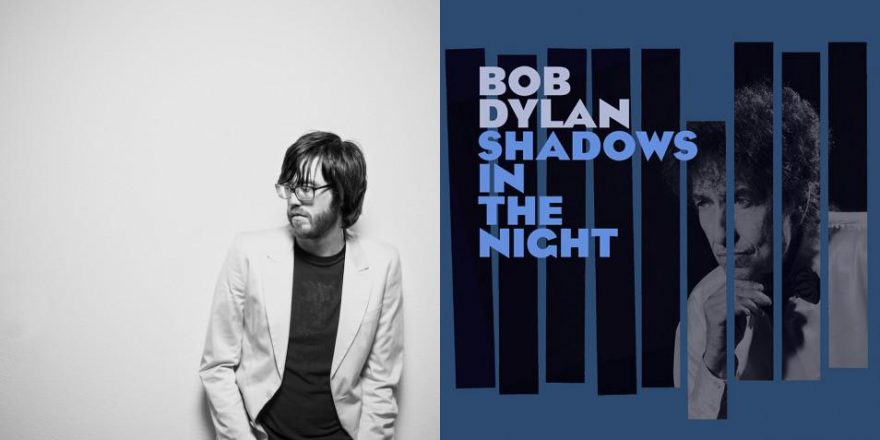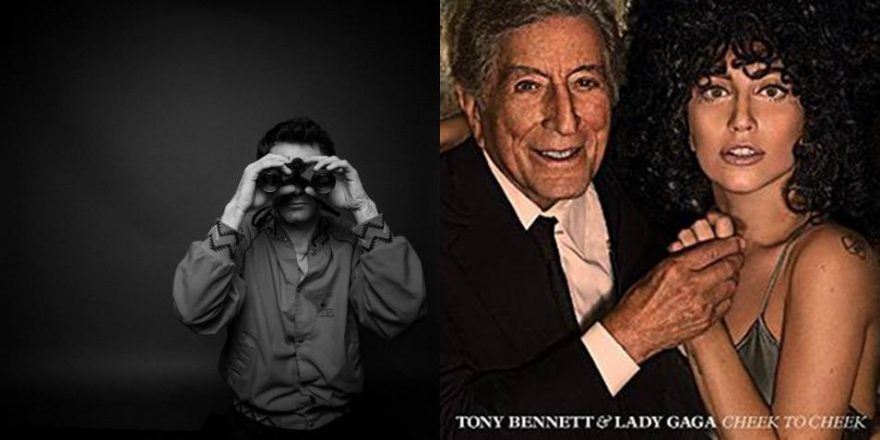You know this already, but membership in an artist’s superfan club — the rarities-chasers, the drinkers of the Kool-Aid, the derided-album-reappraisers — also means you’re afforded special allowance to give the object of your worship the occasional extra-hard ribbing, the noogie that’s just slightly more bruising than what a casual fan would dole out. This is because you love the artist extra sincerely, or at least that’s what you’ve convinced yourself. And I am that to Dylan. I have drunk nauseating amounts of that Kool-Aid, I have chased those rarities, I have paid and then overpaid my dues, and I have thus convinced myself it’s my right to laugh harder and louder than anyone else at the Christmas album, at the Victoria’s Secret commercial, at whatever feels like a misstep. So when I heard that Dylan — who, at age 73, has reached his all-time death’s-head croakiest — was putting out an album covering songs made famous by the smoothest, richest, most confident male voice of the 20th century, and furthermore that he would be giving away 50,000 copies to members of the American Association of Retired Persons, I figured this piece would be another occasion to laugh hard and loud, and this time publicly and for money. But as I listened to Shadows in the Night, Dylan’s cover record of songs associated with Frank Sinatra, I could feel the hilarious takedown I’d already crafted in my mind start to crumble. This record isn’t a weird curveball, it isn’t a joke, it isn’t a misfire, and it’s not fun to view through any of those lenses.
Actually, it’s the most sincere Dylan we’ve had in quite a while, and the most succinct, and kind of the most satisfying. While I’ve enjoyed a lot of Dylan’s more recent work and it’s been inspiring to watch him blaze a trail into uncharted territory, the most influential rock writer of the 20th century charging towards the end of his life as prolific as ever, the results have been uneven and a lot of the time I’ve been bored. There’s a bravery to late Dylan — a bravery in how ugly his voice often is, in how comfortable he seems to be evoking his own mortality, in his flashes of old-fashioned sentimentality — but there’s also a flabbiness. Dylan’s recent records have been self-produced and they show evidence of an artist who has spent his whole life answering to no one, and not necessarily in a good way. Each new release features some percentage of timeless compositions surrounded by long, meandering, melody-less blues songs that don’t seem to end, and with lyrics that don’t seem to relate to anything. You get the sense that there’s no one in the room ballsy enough to tell Dylan his song would be just as good with four verses instead of twelve, to push the drummer away from a shuffle beat, to ask the writer to clarify what he’s trying to say.
Shadows in the Night doesn’t have those problems. These songs are short, polished, and perfect, with their emotional content clear and on the surface, the melodies indelible, the lyrics shaved down to only the most necessary words. And Dylan knows it, and he sings like he knows it. You can sense him trying hard to live up to these songs. In a touchingly unguarded interview with AARP magazine, he calls Sinatra, “the mountain you have to climb, even if you only get part of the way there,” and Dylan sings like he’s climbing a mountain (he even wheezes a little). These vocal performances are not graceful. Age and overuse have sanded the mellowness of Dylan’s Nashville Skyline (1969) singing style away to almost nothing, and he wavers in pitch and in breath when he hits Frank’s long, perfect notes, but that’s also what’s affecting about them. You feel like something’s on the line for Dylan. He is struggling to bring these songs across to you, and in struggling he sounds less like an untouchable icon of the 20th century canon and more like a stunned, confused human being. The lyrics of “Stay with Me,” the best performance on the record and one of the least well-known songs, make this explicit, as Dylan sings “I grope and I blunder, and I’m weak, and I’m wrong, though the road buckles under where I walk, walk along… I find, to my wonder, every path leads to Thee.” This is a human, groping, blundering Dylan, and I’ve missed him. This is the Dylan who sang “When He Returns” sounding near tears, begging to see God during his much-lampooned Christian period. This is the Dylan who moaned, “Your long-time curse hurts but what’s worse is all this pain in here. I can’t stay in here… ain’t it clear?” on Blonde on Blonde (1966) and it seemed like the almost impenetrable emotional wall of that album was about to splinter, painfully and embarrassingly, and all the need and confusion was going to flood out.
Dylan makes an interesting comment about that era — that gloriously psychedelic, Technicolor-Rimbaud late-’60s hit-streak that is my favorite run of his — in his AARP interview. Actually, he makes fun of one of my all-time favorites of his songs, “Queen Jane Approximately.”
“I’m a Fool to Want You” — I know that song. I can sing that song. I’ve felt every word in that song. I mean, I know that song. It’s like I wrote it. It’s easier for me to sing that song than it is to sing “Won’t you come see me, Queen Jane.” At one time that wouldn’t have been so. But now it is. Because “Queen Jane” might be a little bit outdated. But this song is not outdated. It has to do with human emotion. There’s nothing contrived in these songs.
“Queen Jane Approximately” was recorded by Dylan near his ultimate ascendance. While Sinatra had spent the past decade overshadowed by rock & roll and lashing out at its practitioners, Dylan’s influence had transformed the musical landscape (at least cosmetically), and one of his primary themes was that the times were changing and the old gatekeepers were going to fall, inevitably, resoundingly, humiliatingly. His most violent iteration of this theme, “When the Ship Comes In,” is a bald rewrite of Kurt Weill and Bertold Brecht’s “Pirate Jenny,” and was apparently inspired by Dylan’s ill-treatment at the front desk of a ritzy hotel; it climaxes with Dylan imagining his legion of foes drowning before the whole world’s eyes as they beg for mercy. And Dylan’s most iconic battle against the old guard was when he famously “went electric” at the 1965 Newport Folk Festival. Most of us are familiar with the narrative surrounding Dylan at Newport — the boos, the volume, Pete Seeger apparently trying to cut some power cables with an axe — but my favorite account comes from Joe Boyd’s 2006 memoir White Bicycles, in which the producer describes the mood backstage immediately after Dylan’s performance: “The atmosphere was somber and silent… The old guard hung their head in defeat while the young, far from being triumphant, were chastened. They realized that in their victory lay the death of something wonderful. The rebels were like children who were looking for something to break and realized, as they looked at the pieces, what a beautiful thing it had been.”
Post-Newport, Dylan started writing inwardly focused songs full of surreal and intensely personal imagery. An open, inviting style of writing was replaced by dense narratives that seemed to be written in code. Was he talking about Andy Warhol? Was that a reference to speed? Is this song about Edie Sedgwick? Dylan wasn’t bringing his songs to the listener, he was hiding behind them, and if you wanted to know what he was talking about you had either to pretend coolly you did or try to fight your way through the lyrics for the meaning, even if it meant digging through Dylan’s trash for clues, like the “Dylanologist” A.J. Weberman.
I think Dylan regrets this, and even feels a little embarrassed by it. I think that’s what he means by his comment about “Queen Jane Approximately” being “outdated.” After half a century, who really cares about what it was like to date Edie Sedgwick or Joan Baez? What’s fun about “Queen Jane Approximately” is that you get to pretend to be Dylan, jet-setting around the New York celebrity scene of the late ’60s. But that’s a limited kind of fun, and it’s not very helpful. Meanwhile, the best Sinatra songs, especially the ones Sinatra called “suicide songs” that appear on albums like Frank Sinatra Sings for Only the Lonely (1958) and Where Are You? (1957) (Dylan covers four songs from Where Are You?), are about the ordinary pain of ordinary people in love with other ordinary people. You can relate to them, almost uncomfortably so. As Dylan says, “I’ve felt every word in that song… It’s like I wrote it.” Yeah, it’s like I wrote it too. It’s like everyone wrote it. These songs don’t hide inside a fortress of amphetamines and polka-dots and Wayfarers and hagiography. They walk out and meet you and speak in a language that is a streamlined, sublimely poetic upgrade of your own.
There’s something about Shadows in the Night that almost feels like a capitulation. At the cultural moment when Dylan was zigzagging the globe sneering “Like a Rolling Stone” and “Queen Jane Approximately,” I bet Sinatra would have killed for the spotlight. And now a septuagenarian Dylan’s holing up at Capitol Studios, one of the most famous studios Sinatra worked in, and telling AARP, “I think he’d be proud, in a certain way.” But Dylan’s been hinting at that love for the beautiful thing he helped break at least since Nashville Skyline, and his catalogue is full of songs that aim for the kind of simplicity of expression that you hear in every verse of Shadows in the Night. Really, capitulation is Dylan’s bravest move in years, because it represents a stronger commitment to being truly great and to being actually honest (in his interview Dylan talks about himself as an old man and says, “passion is a young man’s game”) than to the cult of Dylan. These songs are simple, the arrangements are perfect, and Dylan is fully exposed, right there up front, human and willful and humble, falling far short of Frank, telling it like it is.








